Pycnogonida |
Pantopoda |
Colossendeidae
Environment: milieu / climate zone / depth range / distribution range
Ecology
Benthic; depth range 15 - 3935 m (Ref. 1680). Polar
Indo-West Pacific, South Atlantic and the Antarctic.
Length at first maturity / Size / Weight / Age
Maturity: Lm ? range ? - ? cmCommon length : 25.0 cm LS male/unsexed; (Ref. 9)
Trunk and proboscis large but size only intermediate with leg span of about 25 cm. Ocular tubercle quite low with small eyes. Proboscis broadly expanded from narrow base, sown curved, longer than trunk. Palp longer than proboscis, distal 3 segments subequal in length. Oviger terminal claw opposed by subchelate larger spine forming pincer-like claws. The propodus is only 0.6 as long as the tarsus and the terminal claw is short (Ref. 9).
Continental rise (Ref. 1456); continental shelf, continental slope (Ref. 1456 and 19).
Life cycle and mating behavior
Maturity | Reproduction | Spawning | Eggs | Fecundity | Larvae
Members of the class Pycnogonida are gonochoric and sexually dimorphic. During copulation, male usually suspends itself beneath the female. Fertilization occurs as the eggs leave the female's ovigers. Males brood the egg masses until they hatch. Life cycle: Eggs hatch into protonymphon larva then to adults.
Child, C.A. 1998 The marine fauna of New Zealand: Pycnogonida (sea spiders). NIWA Biodiversity Memoire 109. National Institute of Water and Atmospheric Research (NIWA). Washington, D.C. 20530, USA. 71 p. + Figure 2A-G, 3A-F, 4, 5. (Ref. 9)
IUCN Red List Status
(Ref. 130435: Version 2025-1)
CITES status (Ref. 108899)
Not Evaluated
Not Evaluated
Threat to humans
Harmless
Human uses
| FishSource |
Tools
More information
Trophic EcologyFood items (preys)
Diet composition
Food consumption
Predators
Population dynamicsGrowth
Max. ages / sizes
Length-weight rel.
Length-length rel.
Length-frequencies
Mass conversion
Abundance
Life cycleReproductionMaturityFecunditySpawningEggsEgg developmentLarvae PhysiologyOxygen consumption
Human RelatedStamps, coins, misc.
Internet sources
Estimates based on models
Preferred temperature
(Ref.
115969): -1.9 - 4.1, mean 0.8 (based on 1436 cells).
Price category
Unknown.
